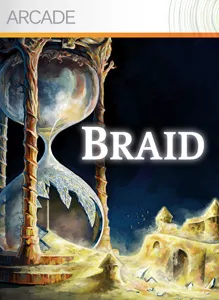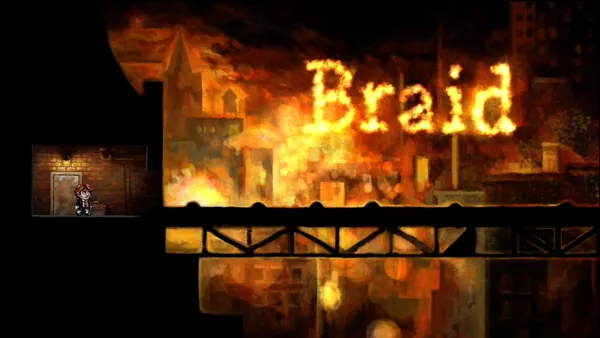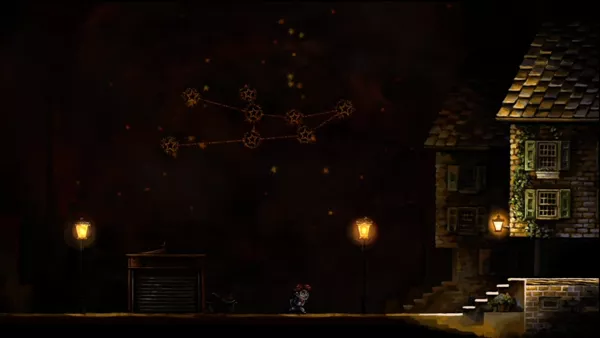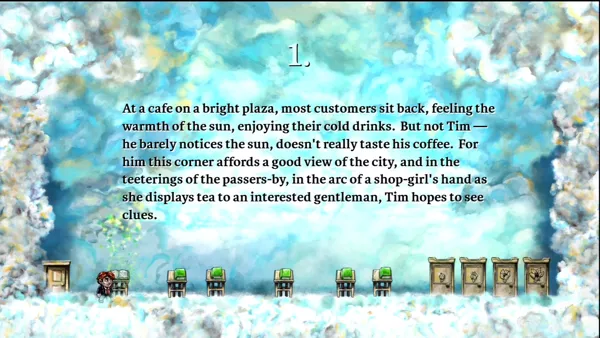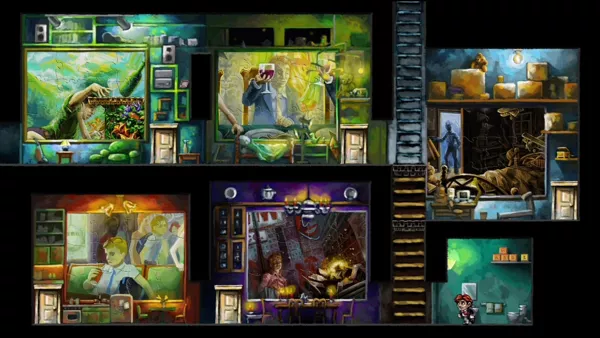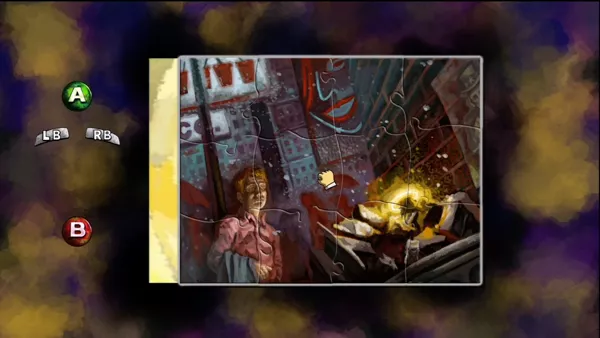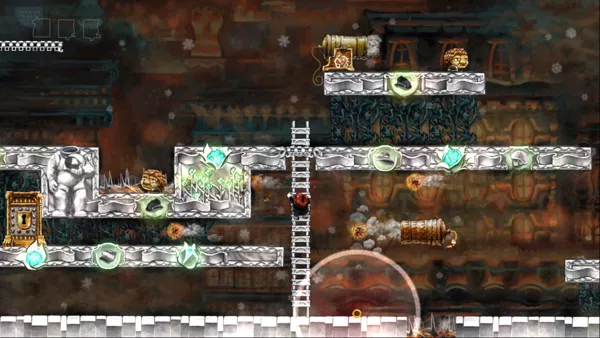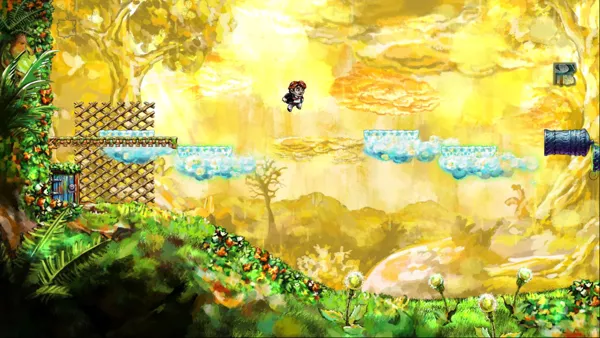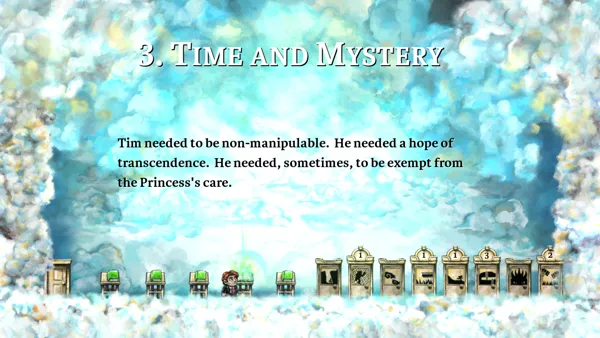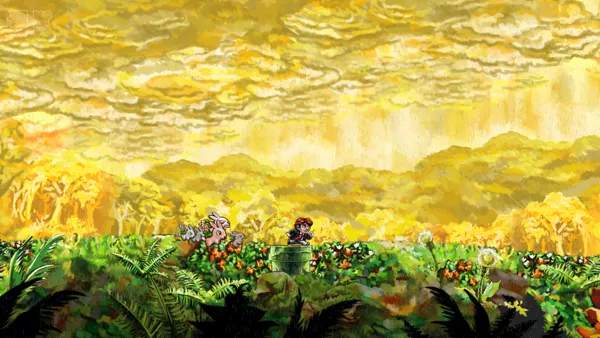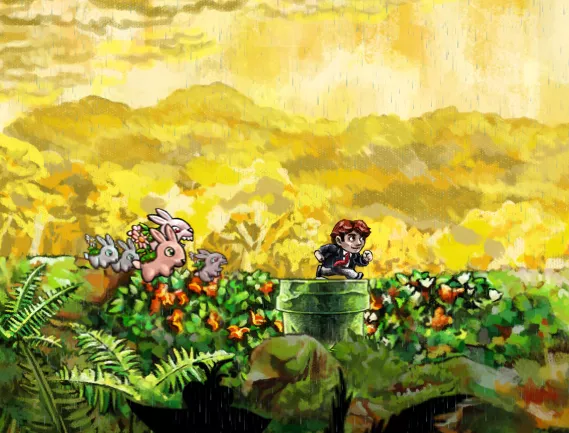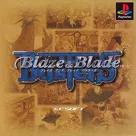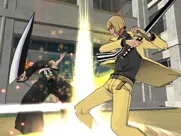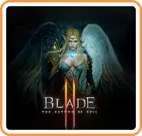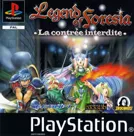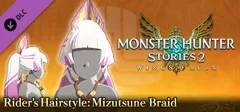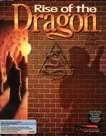Braid
Description official descriptions
Braid is a puzzle game disguised as a 2D platformer. The player controls Tim during his search for a princess he has known and lost. Although the objective appears to be rather straightforward at first, the meaning and the motives become much more implicit and are interwoven with the mechanics during the course of the game. From the main hub, Tim can eventually access six worlds that consist of different areas. The start of each world reveals a part of Tim's background and emotions, rather than progressing a storyline. The second to the sixth world can be entirely explored without solving all the puzzles. Difficult situations can be ignored and revisited later. When all worlds have been completed, the first one becomes available and brings closure to the story.
The game's concept is entirely based on time manipulation. Tim cannot die permanently as the player can rewind time at any moment and usually for any length, even all the way back when an area was entered. While rewinding, the music is synchronized in a similar fashion. Rather than a gimmick, rewinding is an essential element to solve the puzzles. The different worlds give a spin to the mechanic by introducing clones as the player collaborates in a parallel reality with a past version of himself, time can be affected through the movement direction, and Tim can create a circular area to cause time dilation. Certain items, enemies, and parts of the scenery are immune to time manipulation or behave in a very different way. Puzzles require close examination of the environment and the behavior of different items and enemies. As such, the game is entirely about solving the puzzle theoretically by applying the game mechanics and then using trial and error to executive it and discover possible flaws in the proposed logic. This also brings limited replayability to the game.
A world is solved by collecting the puzzle pieces. These need to be arranged and eventually show a picture related to the game's story. There is no filler in the level design, meaning that every platform, item, or game element (except for a few enemies) has a specific purpose to solve a puzzle. Fast times can be tracked in a separate speedrun mode.
The later released Windows and Macintosh versions are identical but come with a level editor.
Spellings
- ブレイド - Japanese spelling
Groups +
Screenshots
Promos
Videos
Add Trailer or Gameplay Video +1 point
See any errors or missing info for this game?
You can submit a correction, contribute trivia, add to a game group, add a related site or alternate title.
Credits (Xbox 360 version)
86 People (77 developers, 9 thanks) · View all
| A Game by | |
| Graphic Art by | |
| Additional Graphical Effects Programming by | |
| Animation Prototyping by | |
| Additional Sound Effects by | |
| Helpful Patron | |
| XBLA Facilitation | |
| Room and Board | |
| Rewind Evangelist | |
| Play-Testing and Discussion | |
| Special Thanks | |
| [ full credits ] | |
Reviews
Critics
Average score: 92% (based on 75 ratings)
Players
Average score: 4.1 out of 5 (based on 146 ratings with 7 reviews)
The Good
Thinking about the moments I played Braid, mostly late at night, it brings back the range of emotions that went through me. In the dimly lit room, the game took me on a grand voyage of surprise, frustration, victory and sadness. It was a sensation I can only compare to some of the best titles I have played, such as Shadow of the Colossus, the first Monkey Island, Ecstatica or Dreamweb. A large part of my enjoyment of those is because they arrived at the right moment in my life and fit the way past games shaped me as a gamer and my expectations for new experiences. Braid is different however, as it has many layers you need to peel away at first. It is a game with many disguises and your enjoyment will depend on plunging through the different surfaces.
To understand why this game is so different, you need to know more about the author, Jonathan Blow. The past few years, he has been very vocal about the industry and trends, loathing design choices of heralded games such as Half-Life 2 and calling World of Warcraft a treadmill of tedium, a drug, the junk food of gaming. He labels the game "unethical", saying it provides simple rewards for a suffering scheme to keep players in front of their computers. Much as why I am drawn to indie games, he longs for the sense of wonder that pulled him in as a kid. But growing up, expectations change and he feels too few games manage to grow along with a maturing audience.
Secondly, he says games have to find their own voice, in the way music captures through sound, books through words and imagination, and movies through images. Too often games mimic tried concepts of other media. For games, this has to be the game mechanic itself, something inherent to the idea of a game. Blow also loathes cut-scenes as a way to tell a story, it should stem from the gameplay. In that way, Braid is not a game to attract a new audience, it's a gamers' game. While I expected a game such as Heavy Rain to take storytelling one step further, Blow does it through the age-old concept of a platformer. Yes, Braid is just a regular platform game, no different from Super Mario Bros. and nothing in the game design is particularly new. That means that with no instructions available, anyone knows instinctively how to play. You walk, you jump, that's all there is. While exploring the worlds however, accessed through the protagonist's house, further game mechanics are discovered rather accidentally with small hints. You find out you can rewind time, retracing every step you have taken in a level and back as far as you want. Each world uses a variant of time manipulation. The way time is manipulated does not become increasingly complex and difficult. In some worlds you reverse time (and as such you can never die), in others time changes according to your movement, you collaborate with a past version of yourself in a parallel reality or slow down time in a specific area. The platforming is eventually a false sense of familiarity, as Blow uses it as a vehicle to tell his story, twisting the genre into unexplored paths. It does not even matter if you like platformers.
Time manipulation is the only mechanic you need to learn and you use it solve puzzles. Certain objects and items are affected differently through time and you need to distort reality to turn it to your advantage. Almost all worlds can be travelled right away. There are no enemies you absolutely need to kill, you can just walk straight through a world and decide to finish it later, a very meditative experience. Each world holds a number of puzzle pieces that need to be collected and arranged into a frame to reveal a photo. The story about Tim's seemingly simple quest for a princess is carefully mixed into the gameplay, even though Tim never speaks and does not meet anyone directly relevant to the story. He is also very out of place, a tiny man in a suit with his hair neatly brushed in a fantasy world, but this is for the player to discover. The way time is manipulated and puzzles are solved is a part of the storyline itself. Before attempting to grab a puzzle piece, you need to examine the behaviour of enemies and items, imagine how your time manipulation can affect them and devise a strategy. Mostly, you will be solving puzzles by devising a pattern in your mind before even trying. If it does not work, you rewind time, look where you went wrong and adapt your strategy. The puzzle pieces that form pictures resemble Tim pondering his past, trying to fit the pieces. Final clues to the story are provided through a few sentences at the beginning of a world. Very little is revealed and the search for the princess soon becomes a metaphorical quest for something completely different. Like a poem, with so little details, it is profound and deeply moving, yet largely implicit and asks the player to work it out himself. Even more, you can easily ignore the entire story as there are no sequences where you are forced to read or interpret, it is entirely optional. But when you do get to the final world however, the mixed and reversed storytelling leads to a tremendously powerful ending where everything you thought you knew is brought into a very surprising perspective you could not possibly imagine.
The gaming roots also show. The end of a level, “The princess is in another castle”, a sentence burned into the collective gaming history, is given an entirely different meaning in this game. The cheerful graphics will deceive the player how much of a melancholic reminiscing about regret it is, though it is open for interpretation.
The quiet atmosphere is enhanced through fitting music and beautifully drawn graphics. They complement and dearly need each other. The way rewinding time is reflected in visuals and music is stunning. There is also no filler. All puzzles and scenery have a meaning in the game. Even though it can be considered quite short, none of the gameplay seems abundant or meaningless, everything is moulded together with mathematical precision. After finishing the first five worlds, a ladder can be constructed to the attic in the house where a final world brings closure to the story. It is not told in a linear way however. Each sequence reconstructs another memory and your insight into the events constantly needs to be adjusted. Many of the puzzles seem very difficult at first, but there is always a logical solution. They are hardly ever the same and the ingenuity of some will leave you baffled. When you finally figure it out, you feel a great and deserved sense of accomplishment.
The Bad
It is not a game for everyone. If you cling to a certain genre Braid can be disappointing. There is no action without meaning, no dying, and no enemies to defeat without a purpose. You can finish a level without any action at all. Without the background story, as faint as it may seem, this game would not make sense. If you don't grasp all the elements that make up the game world, it doesn't work. On paper it seems poor game design, but Blow is incredibly clever in his presentation. You grow along with the game and it is hard not to be impressed by the maturity carefully crafted into the game design when it fully reveals itself. This game is however a must for anyone who has been playing for many years, as a mosaic that brings together some of the best elements from gaming history (hence the title) with fresh ideas.
The Bottom Line
Braid is a one-of-a-kind experience, a game stronger than anything else released before, because it is not ashamed of being a simple game at the surface. It acknowledges everything that precedes it, but refuses to be influenced by other types of culture. As Blow once said, there will eventually be games you cannot explain or compare. You simply need to have played them to know what they are. Through the humble, yet familiar game mechanics, Braid tells a story that puts almost everything on this site to shame. When it finally comes to full bloom in the end, it stands tall as a masterpiece that mocks every revolution the game industry has been preaching. As such it deserves my humble praise and a hearty recommendation.
Xbox 360 · by Sciere (931410) · 2009
The Good
Cool characters. Tim is a short guy that looks mature and wears suits and a tie. The way he looks is symbolic of an old soul trapped in a young/infantile body. It is itself a paradox of time. The main characters, however, are a bunch of lions that Tim jumps on in order to gain access to higher ground. The basic obstacles are similar to Metroidvania games. You can only jump so high, so figure out a way to jump higher. You can't crawl through narrow passages, and you can't morph into a ball. The lions can get there and get the items for you.
Visually fascinating. While the gameplay itself is almost zero fun, I kept playing due to the beautiful graphics, and the following reason.
Deep thoughts and sophisticated views about life, the universe, and existence. I'm touched by World 3 and World 5 especially. In World 5 you create a parallel universe version of yourself, and work with that alter-ego to accomplish a goal together. It makes you ponder upon the choices you have made in life, and how things may have turned out differently. In World 3 a type of glowing objects is introduced that isn't affected by time. It's a symbol of eternity, The Constant, the things in life that never change no matter what happens, such as family, such as There Is A Light That Never Goes Out.
You can't die. It's a game with an undo button that can undo everything you have done. Obviously inspired by the game/software development process itself, as you can type something, change a line of code and then undo. This is a very, very cool and useful feature, that would have been very helpful in a lot of other games.
The Bad
However, Braid doesn't feel any more user-friendly with this unlimited undo feature. You can't die. But you can't solve the puzzle either. About 20% of the puzzles can be solved by a normal person. About 20% more can be solved if you think really hard. The rest of the puzzles are too difficult. Braid really could have been 500% better, if it had just included a hint system. Give me three hints to each puzzle piece. I have to do things to earn the hints. That'll make the gameplay fun. But right now, it's not fun at all, and you constantly have to read a guide just to complete the level.
After reading the guides, it seems that each puzzle has only one, unique solution. How can a game that covers a topic so broad and deep, be so narrow-minded at the same time?
How about this: Let's summon Tim right now and rewind back to the day Braid was released, and surround Jonathan Blow, the project manager, with a bunch of lions and rabbits that are immune to everything ever. The lions and rabbits will not go away until Jonathan Blow give us three hints to each puzzle.
The Bottom Line
Unless you have the ability to manipulate time, and then manipulate Johnathan Blow, there really isn't any fun in Braid. It's probably not meant for that either. A game that aims to provide not fun, but deep questions, and eternal answers.
Windows · by Pagen HD (146) · 2013
The Good
When it was released, Braid surprised the whole videogame world because of its combination of platforms and puzzle genres. We must be clear about that, Braid's not a platform game with some concrete puzzles in some certain places, Braid's just the opposite, a puzzle game with a slight platform feel on its design. Braid's key to congeniality is the concept, unique and new in everything like gameplay, storyline or main design. Braid's programming is incredible, playing with the time as no other game has never done.
Time's the main incentive for this game as well as the main headache for the players. The game is divided in different worlds (well... rooms of the main character's house), and each world has a different use of that feature, like going back as if you were Prince of Persia's main character using the sands of time, or using a strange ring that allows you to slow what's near of it. Each world's different, so, what you've done in previous world will not work in the others.
Braid's gameplay is simple, and you'll use (most of the time) just the jump button, and another one to press switches. You have another button to go back in time if you've done something wrong, which means that you're immortal because you can use it all the times that you want or need it. Anyway, you'll realize soon that "loosing a life" is not the worst thing that could happen here (to start with, there are no lives), you won't even hate your enemies, because the main problem are puzzles. Some of them are as complicated as annoying is the main storyline.
Puzzles are perfect, yes, and the best thing on it is the fact that when you play and face one of the puzzles, you'll think that you'll need a skill (like double jumping or something) taken in the future and then come back to where the puzzle is to solve it. Yes, you're right, you can turn back anytime you want to solve those puzzles that you couldn't solve, but there are no skills along the game, what means that you can complete all the puzzles from the start.
Besides breaking player's brain, Braid is a game with good taste, and it pays tribute to many important games such as Super Mario, Donkey Kong or Ghosts 'N Goblins along the adventure. Graphics aren't the best graphics ever seen, but they're unusual beautiful. This feeling is in the whole game, in every art of it, a nice mix including a melancholic story, green stages with many beautiful details and suitable music with clear Celtic influences.
The Bad
Story's a complete nonsense, complicated and annoying. Even the designer admitted it, something abstract without a meaning. When you finish it there are so many different interpretations for what you've played that you'll start looking for an answer and you'll find out that no official explanation exists, only a few clues but nothing concrete. What you see in the game is beautiful until you reach the ending part. Of course, to like or not the ending is something subjective, but that strange story (which is clearly the biggest headache for the player, much more than the puzzles out there) is so annoying that many players will be disappointed once they've spent a lot of time solving those hard puzzles.
Game's length is a big problem because it's really short. Some puzzles need many time to be solved, but some of them don't. Just a pair of them will need many hours, and we must add that we've lost, partly, that spirit of the old school gamer that would never use a game guide, so, it's probably that if you don't know how to solve a puzzle you'll look for extra help, and that makes the game really short (moral: don't use any guide or external help!).
When most of the puzzles are solved, the credit goes to the player. You won't solve puzzles by chance and it won't even help you a bit, but there's a concrete world in which that could happen because of its confusing way of using the time feature. Well, maybe you won't solve puzzles that way, just by chance, but it's possible that you solve some of them repeating different things until you find the correct one, without knowing exactly what you had to do to solve it.
Forget about taking all the secret stars on the game. We're talking about one of those games where secrets are impossible to find by your own way. You won't even know it by intuition, so, forget it or look directly for a game guide.
The Bottom Line
If your looking for a platform game avoid Braid. If what you want is a game with many different puzzles to get a headache or to be proud of yourself once you've solved them, Braid's your game. The design of the game is beautiful, so beautiful that you'll be attracted to it immediately, but what's inside of the game is what makes this game shine with its own light. Besides its short length and the annoying story, one of the most important independent games released.
Windows · by NeoJ (398) · 2010
Discussion
| Subject | By | Date |
|---|---|---|
| Recommended literature | Sciere (931419) | Sep 7, 2008 |
Trivia
1001 Video Games
Braid appears in the book 1001 Video Games You Must Play Before You Die by General Editor Tony Mott.
Budget
Developer Jonathan Blow said he invested about $180,000 of his own money in a three year period to create the game.
Inspiration
In an interview with the website Joystiq on 25th September 2008 Jonathan Blow cites the musical influences that initially lived in the same emotional neighborhood as Braid: the album Horse Stories by Dirty Three, the music of Lisa Gerrard, and the soundtrack to Dead Man by Neil Young.
References
Many of Braid's levels appear to draw their names from various cultural sources: level 3.2 -- There and Back Again -- is from fictitious hobbit Bilbo Baggins' autobiographical account of his adventures in author J.R.R. Tolkien's The Hobbit, while level 3.4 -- The Ground Beneath Her Feet -- is named either after a book of the same name by author Salman Rushdie or the U2 song also inspired by the book. Level 3.6 -- Irreversible -- suspiciously shares a title with a French film told employing an unorthodox time flow, while levels 4.2 -- Jumpman -- and 6.6 -- Elevator Action -- are names of video games. (Level 6.7 -- In Another Castle -- is one of many nods this game plays to the great granddaddy of the platform genre, Super Mario Bros.)
Awards
- GameShark
- 2009 - Best Xbox Live Arcade Game
- GameSpy
- 2008 – XBLA Game of the Year
- IGN
- 2009 - Overall Best Puzzle Game
- 2009 - Best PS3 Puzzle Game
- 2009 - Best PC Puzzle Game
Information also contributed by Big John WV and Sciere
Analytics
Upgrade to MobyPro to view research rankings!
Related Sites +
-
Braid
Official game website -
Braid
TIGdb entry. -
Mac Gamer Review
A review of Braid by the Mac Gamer's Brad Snios, who had a generally favorable outlook on the game and its nature as a port (July 17th, 2009). -
Podtoid 66: Braidtoid
A podcast with Jonathan Blow about the game design, hosted on Destructoid (21st August 2008) -
The Art Of Braid: Creating A Visual Identity For An Unusual Game
Artist David Hellman explains his collaboration with Jonathan Blow to create the art for the game, on Gamasutra (5th August 2008) -
The aesthetics of puzzle game design — A good puzzle game is hard to build
Interview on puzzle game design to Jonathan Blow, author of Braid, along with Sokobond's Alan Hazelden, and Jonathan Whiting, co-author of Traal. -
Wikipedia: Braid
article in the open encyclopedia about the game -
X360A achievement guide
X360A's achievement guide for Braid.
Identifiers +
Contribute
Are you familiar with this game? Help document and preserve this entry in video game history! If your contribution is approved, you will earn points and be credited as a contributor.
Contributors to this Entry
Game added by Sciere.
PlayStation 3 added by Kaminari. OnLive added by firefang9212. Linux added by Iggi. Xbox One added by MAT.
Additional contributors: Kabushi, Pseudo_Intellectual, Solid Flamingo, Zeppin, Patrick Bregger, Starbuck the Third, FatherJack, Kennyannydenny, click here to win an iPhone9SSSS.
Game added August 8, 2008. Last modified June 10, 2024.
